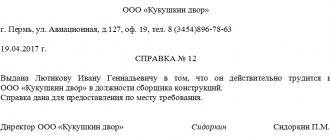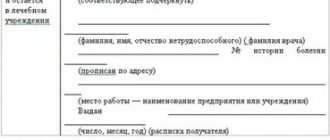The minimum authorized capital for registering an LLC is only 10,000 rubles. This amount is only enough to organize an intermediary business within the walls of your own apartment. What to do if you need money to develop your business, but you don’t want to increase the authorized capital? Let's take a closer look at an interest-free loan from the founder: the tax consequences of 2021.
Who can be a party to the loan agreement
Let us say right away that the legislation does not in any way connect the possibility of concluding an interest-free loan agreement with the legal status of its parties.
This means that commercial organizations, individual entrepreneurs, and “ordinary” individuals can apply for such a loan. The specified legal entities and individuals can act as any party to the interest-free loan agreement, and any combination of these persons is possible. There is also no restriction on concluding such an agreement between interdependent and affiliated persons (as opposed to an agreement for the gratuitous use of property (loan)). This means that an interest-free loan agreement can be drawn up between the parent and subsidiary companies; between an organization and its participant (founder), or between an LLC and its manager (both an individual entrepreneur and a legal entity).
And finally, it is not prohibited to take interest-free loans from the head of the company, as well as from other employees, regardless of their position. Likewise, a company can issue a similar loan to any of its employees.
Check the counterparty for signs of a shell company and the presence of disqualified persons
Accounting entries
Depending on the term, loans are divided into short-term (up to 1 year) and long-term (over one year).
Depending on the type of loan and the source of its issuance, the following entries will be made in accounting:
- Dt 66 Kt 50 – issuance of a short-term loan from the cash register.
- Dt 67 Kt 50 – issuance of long-term loans from the cash register.
- Dt 66 Kt 51 - issuing short-term loans through a bank.
- Dt 67 Kt 51 – issuance of long-term loans through a bank.
Loan from a participant: risk of contract requalification
However, in some cases, when concluding a loan agreement, civil legal risks are still present. They are associated with the possibility of recharacterizing an interest-free loan that an organization received from its founder or participant into a non-repayable contribution to the organization’s property.
The court may make such a conclusion if the loan was issued for a long period (for example, for a period exceeding three years), or the term of the loan agreement was repeatedly extended. The risk also arises if the amount transferred as loans was not claimed after the end of the contract.
Recharacterization of the agreement is also possible in other cases if the court, taking into account the circumstances of the issuance and repayment of the loan, comes to the conclusion that the lender did not intend to get the money back. In particular, the risk zone includes interest-free loans, the issuance of which included such purposes as “ensuring economic activity”, “business development” or “replenishing working capital” (see, for example, the ruling of the Arbitration Court of the Khabarovsk Territory dated 01/09/18 No. A73-18372/2017).
Note that if the court makes such a decision, the lender will lose the opportunity to return his money. However, for the borrower, recharacterization of the agreement will entail tax consequences only if the funds were received from a manager who is not a participant. After all, such a person cannot contribute to the property of the LLC (Article 27 of the Federal Law of 02/08/98 No. 14-FZ “On Limited Liability Companies”, hereinafter referred to as the LLC Law). This means that the borrower will have to include the money recognized as irrevocable as income, since these amounts do not fall within the scope of subclause 3.7 of clause 1 of Article 251 of the Tax Code of the Russian Federation. (We would like to remind you that this rule allows you not to take into account the contribution to the property of an LLC in income only if it was received in the manner established by the civil legislation of the Russian Federation).
Keep records, prepare and submit income tax and VAT reports
How to draw up a loan agreement
If the lender is a legal entity, the Civil Code requires that a loan agreement be concluded in writing, regardless of the amount (Clause 1, Article 808 of the Civil Code of the Russian Federation). However, no special rules have been established for contracts where a legal entity is the borrower. This means that the general rule of Article 161 of the Civil Code of the Russian Federation on the mandatory written execution of agreements concluded by legal entities among themselves or with citizens is in force.
Thus, an interest-free loan agreement under which an organization receives funds must be drawn up in writing. In this regard, in small companies the question arises: how to draw up such an agreement if the money is given by its director (he may also be the only participant)? Indeed, in such a situation, the contract will have two identical signatures of the parties. Will this be consistent with the essence of the contract (i.e., an agreement between two persons), and will it not violate the rule prohibiting the representative from taking actions in relation to himself on behalf of the represented person?
In fact, the above contradictions are only apparent, and there is no violation in the fact that the same person signed the agreement on both the part of the lender and the part of the borrower. Let's explain why.
The prohibition on a representative performing actions on behalf of the represented person in relation to himself contains an important clause: “except for cases provided for by law” (Clause 3 of Article 182 of the Civil Code of the Russian Federation). And one of such cases is provided for by the LLC Law. Paragraph 1 of Article 45 of this law directly establishes the possibility of concluding an agreement between an LLC and its manager, and spells out special rules on interest in such a transaction. The admissibility of the transactions in question is also confirmed by judicial practice (see paragraph 121 of the resolution of the Plenum of the Supreme Court of the Russian Federation dated 06.23.15 No. 25 and the resolution of the Presidium of the Supreme Arbitration Court of the Russian Federation dated 09.21.05 No. 6773/05).
Let us also note that a borrowing relationship can be formalized not only by an agreement signed by both parties, but also by a unilateral receipt or other document confirming the transfer of money by the lender. For example, this document could be an outgoing cash order or a receipt for a cash incoming order (resolution of the Arbitration Court of the Far Eastern District dated May 16, 2018 No. F03-1717/2018).
Separately, we note that in the text of the relevant document (an agreement signed by both parties, a receipt or other document), it is necessary to indicate that the loan is interest-free, or indicate that interest is not charged on the loan amount. If you do not set the amount of interest, and do not specify that the loan is interest-free, then interest will be accrued at the key rate of the Central Bank of the Russian Federation. An exception is a loan issued by one individual (including individual entrepreneurs) to another individual (including individual entrepreneurs), if its amount does not exceed 100 thousand rubles. In this case, it is enough simply not to include the interest clause in the contract. These are the rules of Article 809 of the Civil Code of the Russian Federation.
Draw up and print a loan agreement using a ready-made template for free
Tax consequences
Starting from 2021, the legislator considers receiving an interest-free loan an economic benefit. This benefit is determined in the amount of the Central Bank key rate in force during the settlement period. This period is considered to be a month.
In practice, this means that the borrower must pay monthly personal income tax in the amount of 35% of the loan amount, indexed by 2/3 of the Central Bank key rate.
Taxation example
For example, the founder took out an interest-free loan in the amount of 100,000 rubles on 1.01. 2021.
In January 2021, 7.75%.
100,000*7.75%*2/3*35%= 1,806 rubles. The borrower will have to pay this amount of personal income tax.
If the borrower is not a resident of the Russian Federation, the tax rate will be 30%.
Personal income tax is not levied if the loan was received for the purpose of purchasing or constructing housing, purchasing a room, a house, a plot of land for building a house, etc. In this case, the borrower must retain the right to a tax deduction. If the debtor has already exercised this right, the tax preference does not apply.
Thus, to apply this benefit, the tax agent should rely on a document confirming property rights to the above-mentioned objects and official confirmation of the right to a tax deduction from the Federal Tax Service.
In this case, the creditor company is a tax agent and is obliged to withhold personal income tax from the founder’s salary (if he is on the company’s staff) or from dividends.
What is considered material benefit?
Since 2021, changes have come into force regarding the recognition of interest-free use of a loan as a material benefit. They are enshrined in Federal Law No. 333-FZ of November 27, 2017, and fix two defining features of material benefit.
If at least one of them is present, then interest-free use of the loan is recognized as a material benefit:
- If the borrower is an employee of a business entity or is in another interdependent relationship (founder);
- If the borrower's failure to pay interest is financial assistance or satisfaction of the lender's obligations to the borrower (including for goods supplied, work performed or services rendered).
These rules also apply to loan agreements concluded before 1-1/2018 (letter of the Ministry of Finance dated 06/26/2018 No. 03-04-07/43786).
How to minimize tax expenses?
The monthly obligation of the borrower to pay tax on material benefits when using an interest-free loan is clearly stated in the law.
It is possible to minimize tax expenses by taking out a loan at minimal interest - slightly above 2/3 of the Central Bank key rate.
In this case, the company pays tax as for non-operating income. These incomes are subject to income tax, the base rate of which is lower - 20% versus 35 personal income tax. In addition, the interest-bearing loan agreement can be extended, making it indefinite.
Taking out an interest-free loan has very conditional benefits, which are offset by the tax burden or even lead to a minus.
Reporting when paying personal income tax on material benefits
Information about the material benefit received and the tax on it should be reflected in the declarations:
- 2NDFL (this type of material benefit is indicated under code 2610)
- Calculated according to form 6-NDFL.
Sometimes the tax agent does not have the ability to withhold money to pay taxes. This can happen if the borrower does not have an employment relationship with the company and does not receive dividends.
In this case, in addition to standard reporting for 2NDFL, it is necessary to inform the Federal Tax Service before March 1 of the year following the reporting year about the inability to pay the calculated tax.
This can be done by providing 2NDFL with sign “2”, and be sure to send this certificate to the debtor himself.
For what period can a loan be issued?
The period for which borrowed funds can be provided is not limited by law. Moreover, the Civil Code of the Russian Federation directly allows for the conclusion of a loan agreement, including interest-free, without specifying a term at all, or “on demand”.
However, there are still some restrictions on the loan term. They are related to the statute of limitations. The fact is that, according to paragraph 2 of Article 200 of the Civil Code of the Russian Federation, the limitation period for open-ended obligations or “on demand” obligations cannot exceed ten years from the date of their occurrence. So it turns out that if the lender claims to return the transferred amount, then an open-ended loan, as well as a demand loan, cannot exist for more than ten years. In other words, so that the statute of limitations does not expire and the borrowed funds do not turn into the borrower’s income, you will have to return the money to the lender once every ten years and enter into a new agreement.
But it is better to fix in the contract the period for which the money is transferred. This period can be any, and it can even exceed ten years. In this case, the above rule of paragraph 2 of Article 200 of the Civil Code of the Russian Federation is no longer valid, and the maximum limitation period is counted from the date of violation of the obligation to return money (clause 2 of Article 196 of the Civil Code of the Russian Federation).
Automatically generate a tax payment invoice based on the data from the declaration and submit reports via the Internet
How to write off an issued loan?
A loan to the founder can be written off in two cases:
- In case of full repayment.
- In case of registration of a debt forgiveness procedure.
Refund
In accordance with the concluded agreement, the founder can repay the interest-free loan either in full or in part, on time or ahead of schedule, as well as on a deferred date by agreement of the parties.
Depending on the method of return, amounts are reflected in accounting entries:
- Dt 50 Kt 66, 67 – return in cash to the cash desk of a short-term or long-term loan.
- Dt 51 Kt 66, 67 – repayment of a short-term or long-term loan through a credit institution.
Debt forgiveness
Any person can forgive a debt to another person, either completely or partially. From a legal point of view, this is an ordinary transaction. Debt forgiveness is regulated by Art. 415 of the Civil Code of the Russian Federation. The law does not impose any special requirements for the loan forgiveness procedure on the founder.
As a general rule, a debt can be forgiven if this fact does not violate the rights of other persons in relation to the lender's property.
According to the Civil Code of the Russian Federation, the debt is considered forgiven from the moment the borrower receives notice of the debt being written off. The debtor may object to the forgiveness of the debt within a reasonable time.
The fact of forgiveness from the date of receipt of the notice is reflected in paragraph 2 of Art. 415 of the Civil Code of the Russian Federation, this clause was introduced relatively recently. Before the advent of this norm, the parties formalized the forgiveness procedure in other ways.
- Drawing up a gift agreement.
- Concluding a debt forgiveness agreement. Often, participants in borrowing relationships consider unilateral notification insufficient and enter into a bilateral agreement. This is not prohibited by law, but it would be redundant. In addition, on the basis of this agreement, in any case, it will be necessary to send the debtor a notice of debt forgiveness.
Regardless of the method of writing off the debt to the founder, the latter receives a material benefit, with which it is necessary to pay personal income tax at a rate of 13%.
The forgiven debt cannot be expensed and therefore reduce the taxable base. This type of cost is not reflected in Art. 346.16 Tax Code. The amount of forgiven debt is included in profit, that is, it is a direct loss for the enterprise.
How much can you lend?
The Civil Code does not contain restrictions on the amount of an interest-free loan that an organization has the right to issue or receive. Accordingly, such an agreement can be concluded for any amount, ranging from one penny to hundreds of billions. However, two points must be taken into account.
The first is related to the form of the loan. If we are talking about a cash loan, then it is necessary to keep in mind the restrictions established by paragraph 6 of Bank of Russia Directive No. 3073-U dated October 7, 2013. Thus, under one loan agreement you cannot transfer more than 100 thousand rubles in cash. This rule does not apply if at least one of the parties to the agreement is an individual who is not an individual entrepreneur (clause 5 of the Directive). Accordingly, in this case, any amounts can be issued or received in cash.
The second point concerns the financial solvency of the lender. In the event of a dispute, the lender can claim a refund if he proves that at the time of issuing the loan he actually had the appropriate financial capabilities (see, for example, the resolution of the Arbitration Court of the Far Eastern District dated 06/09/18 No. F03-2065/2018 and paragraph 3, paragraph. 26 of the resolution of the Plenum of the Supreme Arbitration Court of the Russian Federation dated June 22, 2012 No. 35). Therefore, when specifying this or that loan amount in the agreement, you need to take into account that if the case goes to court, the lender will have to prove that he actually had the money on the date the loan was issued.
Early loan repayment and contract extension
The next point that needs to be taken into account when concluding an interest-free loan agreement concerns the possibility of changing its terms after the transfer of money. Is it possible to extend the period of use of borrowed funds, or, on the contrary, to return them ahead of schedule? Let's figure it out.
As for the period of use of an interest-free loan, the same rules apply here as in the case of a loan issued at interest. Paragraph 1 of Article 810 of the Civil Code of the Russian Federation states that the loan must be repaid within the period specified in the loan agreement. And the Civil Code of the Russian Federation does not contain any restrictions on changing the terms of the loan agreement on the term.
Thus, if the parties decide to adjust the period for which the money is provided, it is necessary to draw up a corresponding additional agreement, fixing a new period in it. Moreover, it can be either larger or smaller than the original one. Also, by means of such an additional agreement, the parties can turn a term loan into an open-ended one or vice versa. Let us note that the condition for a new term will begin to apply from the date of signing the corresponding additional agreement, unless the parties specify a different date in it (clause 3 of Article 453 of the Civil Code of the Russian Federation).
Now let’s consider the possibility of early repayment of an interest-free loan. The corresponding rule is established by paragraph 2 of Article 810 of the Civil Code of the Russian Federation, which “by default” provides the borrower with such a right. Moreover, you can repay the interest-free loan ahead of schedule not only in full, but also in parts. And without any advance notice to the lender. At the same time, paragraph 2 of Article 810 of the Civil Code of the Russian Federation allows other rules to be fixed in the contract. For example, you can establish a ban on early repayment of the loan (either in full or in parts). The parties can also stipulate in the agreement that the borrower must notify the lender in advance about the return of money ahead of schedule.
Also see “How to correctly draw up a loan agreement taking into account the new requirements of the Civil Code.”
Exchange legally significant “primary data” with counterparties via the Internet. Free inbox.
Justification of the legality of a loan from the founder
The founder of a legal entity (individual or organization) has the right to provide borrowed funds to the entity created by him, since the provisions of par.
Chapter 1 42 of the Civil Code of the Russian Federation allows this to be done without establishing any restrictions on such actions for the founders. Moreover, the essence of these provisions was not affected by the adjustments made by the Law “On Amendments...” dated July 26, 2017 No. 212-FZ, by virtue of which Ch. 42 of the Civil Code of the Russian Federation acquired a new edition as of June 1, 2018. The advantages of a loan provided by the founder are obvious, since the question of obtaining it:
- resolved promptly;
- does not require preliminary approvals and systematic provision of data for control, as in the situation with a loan issued by a bank;
- can be accepted on very favorable terms for the borrower (with a longer repayment period or lower interest rate than when applying for a loan from a bank);
- may result in debt forgiveness.
Why does the founder providing the loan agree to such conditions? Because he himself is interested in ensuring the successful operation of the organization in which he has a stake and from which he expects to receive income.
How to take into account the receipt and repayment of an interest-free loan from the founder - a legal entity? The answer to this question is in ConsultantPlus. Learn the material by getting trial access to the system for free.
Tax risks of the borrower and lender
In conclusion, we will talk about the tax risks that arise for the parties to an interest-free loan agreement. These risks are associated with the source of the money being loaned, as well as with the status of the parties to the contract, namely their interdependence.
In itself, an interest-free loan for the borrowing organization does not entail any tax risks, since back in 2004 the Presidium of the Supreme Arbitration Court of the Russian Federation confirmed that receiving an interest-free loan does not generate non-operating income in the form of financial benefits from savings on interest (resolution dated 03.08.04 No. 3009/ 04). And regulatory authorities have recently agreed with this (see letters from the Ministry of Finance of Russia dated January 19, 2018 No. 03-03-06/1/2773 and dated March 24, 2017 No. 03-03-06/2/17311).
Results
A loan from the founder is an operation not prohibited by current legislation. Its provision must be accompanied by the execution of an agreement, a number of conditions of which should be treated with special attention. The interest stipulated by the agreement will be the lender's income and the borrower's expense. With an interest-free loan, there are no tax consequences. A loan forgiven by the lender will become non-operating income of the borrower if the share of the founder in its authorized capital does not exceed 50%.
Sources: civil code of the Russian Federation
You can find more complete information on the topic in ConsultantPlus. Free trial access to the system for 2 days.
Source of money
But the source of money transferred under an interest-free loan agreement is already important. The fact is that if “paid” money is lent, for which the lender transfers interest under a paid credit or loan agreement, then accounting for this interest is at risk. After all, as you know, expenses are expenses that are incurred to carry out activities aimed at generating income (Article 252 of the Tax Code of the Russian Federation). Providing an interest-free loan is difficult to recognize as such an activity.
In addition, in this case, the provisions of Article 54.1 of the Tax Code of the Russian Federation may be applied, which prohibits taking into account expenses for transactions whose sole purpose is to reduce tax. Therefore, if it is established that an organization on the OSNO or simplified tax system (with the object of taxation “income minus expenses”) took out a commercial loan (credit) solely in order to transfer this money to a person on the simplified tax system (with the object of taxation “income”), PSN or UTII , then it will also not be possible to take into account the interest on this loan (credit) in expenses.
Keep records, prepare and submit reports according to the simplified tax system
What if the agreement is interest-bearing?
It happens that the parties also enter into compensation agreements. In this case, when drawing up an agreement on debt forgiveness, interest will be considered received free of charge. And they must be taken into account as non-operating income for profit purposes (clause 18, part 2, article 250 of the Tax Code of the Russian Federation). This opinion is also supported by the judges (Resolution of the Supreme Court No. F10-6189/2017 of 02/06/2018 in case No. A23-7374/2016, the transfer of which to the Judicial Collegium for Economic Disputes of the RF Armed Forces was refused by the RF Armed Forces Resolution of 06/05/2018 No. 310- KG18-6314).
interest-free loan agreement with the founder
Interdependence of the parties
In some cases, the interdependence of the parties can also play a very important role when issuing an interest-free loan. Therefore, when formalizing borrowing between “friends,” you must additionally take into account the provisions of paragraph 1 of Article 105.3 of the Tax Code of the Russian Federation. This rule states: if in transactions between interdependent persons conditions are created that are different from those that would take place in transactions between independent persons, then any income (profit, revenue) that one of these persons could receive, but due to this difference is not received are taken into account for tax purposes by this person (for more details, see “Tax risks: is it possible to enter into transactions between “your” companies and individual entrepreneurs”). It is stipulated that such accounting is possible only if this does not lead to a decrease in the amount of tax credited to the budget or to an increase in losses.
It is clear that getting an interest-free loan on the open market is not at all easy. This means that almost always the gratuitousness of a loan between interdependent persons is due precisely to the fact of such interdependence. And, therefore, under certain conditions, such an agreement may lead to additional tax charges.
For example, this is possible if the borrower applies the simplified tax system with the object of taxation in the form of income, and, accordingly, does not take into account expenses. This means that additional tax accrual to the lender on unearned interest will lead to an increase in budget revenues. As a result, the loan agreement between such interdependent persons falls into the risk zone. The tax authority may apply the rules of paragraph 1 of Article 105.3 of the Tax Code of the Russian Federation and require the interdependent lender to pay tax as on a loan provided at market interest. (If the lender is an individual, then personal income tax; if a legal entity, then tax according to the applicable taxation system - income tax, single tax according to the simplified tax system with any object of taxation).
Thus, before issuing an interest-free loan to a related party, you need to calculate what taxes both parties would pay if they entered into an interest-bearing loan for the same amount and for the same period under market conditions. And compare with current tax liabilities. If the tax amount determined taking into account interest is lower or equal to the current one, then there is no risk of additional assessment under paragraph 1 of Article 105.3 of the Tax Code of the Russian Federation. And if it is higher, the deal is at risk, and it may make sense to consider other financing options.
What to do if you can’t return the loan to the founder’s card?
Repayment of borrowed funds is a mandatory condition of the loan agreement. However, it may be impossible to return the debt to the founder on the card for a number of reasons, for example:
- there are no funds in the current account;
- The bank account is blocked by the tax authorities;
- in other cases (the bank’s license was revoked, etc.).
If financial difficulties are temporary and sooner or later the company will have the opportunity to transfer the debt under the loan agreement to the founder’s card:
- agree with the lender on the extension of the loan repayment period, review the payment schedule;
- formalize the revision of the terms in an additional agreement to the loan agreement, attach an adjusted payment schedule to it;
- check whether, due to the extension of terms, the loan has become a long-term loan - detailed analytics in this matter allows you to correctly fill out the explanations for the accounting statements and provide its users with complete and reliable information about the company’s borrowed obligations.
This publication will tell you in which line to reflect borrowed capital.
If the company’s financial situation does not improve in the near future and there is no possibility of repaying the debt to the founder under the loan agreement, it is necessary to consider other ways to resolve the issue with the hanging debt. Find out about one of these methods in the next section.








